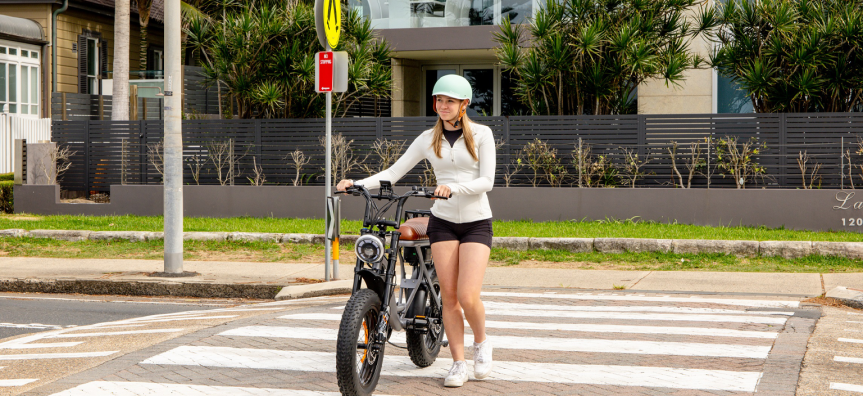E-bikes have soared in popularity, but before you head out, make sure you know the relevant rules to keep you, and those around you, safe.
Permitted e-bikes
There are 2 types of permitted e-bikes:
- Power-assisted pedal cycles
- Electrically power-assisted cycles (most common in Australia)
These must be designed to be propelled primarily by the rider and cannot exceed 25km/hr. Modifying the speed capacity of an e-bike could mean you are changing it from a bicycle to a motorbike.
Potential consequences are:
- Riding an unregistered motorbike, with a potential fine starting from $723
- Driving a vehicle without a license, with a potential fine starting from $899.
- Public Liability implications - insurances may be void if riding an unregistered vehicle without a license.
Electrically power-assisted cycles
This is the most common type of e-bike in Australia.
Key things to know:
- They have a maximum power output of 500 watts
- E-bikes can be propelled by the throttle only, up to a maximum speed of 6km/h. This is considered an approximate walking pace speed, and is intended to assist in getting the bike started.
- The power will cut off when the bicycle reaches a speed of 25km/h, or you stop pedalling and the speed exceeds 6km/h.
Helmets
Helmets are not just a good idea, they are a legal requirement for all bicycle riders, including those on e-bikes. Like them or not, kids, teens and adults need to wear them. Learn more about helmets.
Road rules for e-bike riders
E-bikes are currently subject to the same rules as bicycles, including:
- Keeping to the left and giving way to pedestrians on paths
- Having and using a bell on your bike to warn others you are approaching
- Not riding across a pedestrian crossing, unless there is a bicycle lane, or a green bicycle light
- Only children under 16 years of age can ride on a footpath, or adults when they are with a child under 16
- Having a white light at the front of the bike, and a red light and a red reflector on the back of the bike
Learn about riding on the road.
Liability and insurance
In the event of an accident, ensure you or your child are covered for personal and public liability for injuries and property damage. Parents may be held responsible for their child’s behaviour.
Consider looking into bicycle insurance to protect your family against potential liability issues. Bicycle NSW provides insurance to its members.
Remember, insurance is void for illegal devices, so ensure your e-bike complies with regulations.
Introduction to riding
While there is no formal learning process to ride an e-bike, take your time to learn the rules and etiquette of sharing roads and paths with other users – it’s a big responsibility.
Take it slow for the first few months. It takes time to understand the bike, traffic rules, develop respect for pedestrians and become aware of your surroundings. Consider taking some formal lessons for learner riders.
If you are a parent, consider implementing an induction process before your child rides independently. You could go on some supervised rides to help them safely navigate their regular routes and develop awareness of road rules at etiquette before they ride on their own. Similar to teaching a learner driver!
Plan your trip
Plan your route to use bike routes and off-road shared paths for a safer trip. Find out where they are on the Safe Cycling Network and on our simple local routes.
E-bike and e-scooter fire risk
E-bikes commonly contain lithium-ion batteries. These batteries pose a number of risks including explosion and fire, particularly when used in products that are not manufactured to meet the relevant Australian standards.
To reduce the risk of incidents caused by e-bike and e-scooter batteries we suggest following Fire and Rescue NSW’s list of recommendations.
While e-bikes sold in Australia meet the legal requirements, there is currently no quality control over e-bikes purchased and shipped from overseas retailers.
E-scooters and other motorised wheeled devices
- Personal e-scooters are illegal on NSW roads and paths, including bicycle lanes.
- Other motorised wheeled devices such as e-skateboards, e-hovercrafts, e-mono-wheels and e-segways are also illegal on NSW roads and paths.
- They can only be used on private property.
- Fines start from $723.

